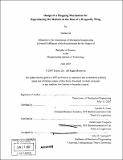Design of a flapping mechanism for reproducing the motions at the base of a dragonfly wing
Author(s)
Liu, Teresa (Teresa H.)
DownloadFull printable version (7.244Mb)
Other Contributors
Massachusetts Institute of Technology. Dept. of Mechanical Engineering.
Advisor
Lynette A. Jones and James Louis Tangorra.
Terms of use
Metadata
Show full item recordAbstract
Insect flight is being studied to aid in the development of micro-air vehicles that use the flapping wing model in an attempt to achieve the high levels of maneuverability that insects have. The flight of the dragonfly has been chosen to be modeled because of its exceptional flight capabilities. This thesis addresses the flapping mechanism designed for the root of each wing. The prototype of the mechanism, built at a scale of four times the size of a dragonfly having a wingspan of 150 mm, is able to create motions in the wing of flapping and feathering, and can vary the stroke plane. The coning angle can be set between tests. The design process began with considering two methods of actuation, a four-bar transmission mechanism used in the Micromechanical Flying Insect developed in the UC Berkeley Biomimetic Millisystem Lab, and by pivoting the wing support directly with cables or rigid links. The second design was chosen to be developed further. A functional prototype was built from acrylic and parts made using stereolithography.
Description
Thesis (S.B.)--Massachusetts Institute of Technology, Dept. of Mechanical Engineering, 2007. Includes bibliographical references (p. 48-49).
Date issued
2007Department
Massachusetts Institute of Technology. Department of Mechanical EngineeringPublisher
Massachusetts Institute of Technology
Keywords
Mechanical Engineering.